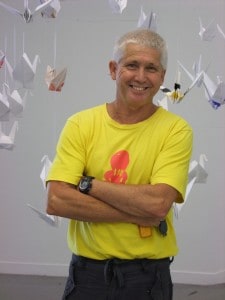
Associate
Professor
Steve Gibbs :
“Toihoukura doesn’t
operate in a vacuum …
and we have two main
things happening in our
favour – the geographical
location of Tairäwhiti,
and that our teaching
is based on Tairāwhiti
kōrero. So, it lives here
with us.”
As an artist and art educator, Associate Professor Steve Gibbs’ goal has always been to teach students about creative visual thinking.
This is how students embed the Toihoukura philosophy of looking to the past to inspire the future into their creative lives. This strategy enables them to create their own dreams and aspirations based on their acquired knowledge.
“Toihoukura doesn’t operate in a vacuum,” he says, “and we have two main things happening in our favour – the geographical location of Tairāwhiti, and that our teaching is based on Tairāwhiti kōrero. So, it lives here with us.” To illustrate creative genius in his classes, Gibbs references great Tairāwhiti artists Iwirakau, Hingangaroa and Rukupo. All were exponents of carving, and stablished renowned wänanga (higher learning institutions) around the region. From the 1300s, the Iwirakau School at Waiapu and Rawheoro in the Uawa district were followed by the 1800s Manutuke based school, founded by Raharuhi Rukupo. The great prophet, Te Kooti, had an impact on the artistic expression of his time which was both visual and spiritual, and Sir Apirana Ngata and brothers Pine and Hone Taiapa are their contemporary counterparts. “These artists created this whole other kind of creative thinking. But, creativity also involves identifying differences from other sources, and other cultures.” Gibbs has always pursued research avenues to further explore this notion.
In 2011, he visited Spain where he investigated artists and architects that forever changed the face of art globally. “Picasso, Miro, Goya and – my personal hero Antoni Tapies – were producing extraordinary work, and changed the way people thought about art.”
Gibbs spent some time moving around different galleries and educational institutions in Barcelona to see what was being exhibited and taught. He describes his visit as enlightening. One of the main aspects that caught his interest was that all these ‘greats’ undertook their training in Barcelona.
Gibbs’ research showed that the art created by great Māori artists was, in his view, equivalent to anything that appeared in Europe. The Gaudi cathedrals and the intricately carved traditional houses of Tairāwhiti are parallel in terms of creative thinking, retention of cultural expression and comparative creative genius. One of his research outcomes was to produce a series of paintings from his Spain experience. These works comment on contemporary Spanish society and its history as a former colonial power.
As part of his PhD, a different yet related direction he has taken is Gibbs’ research and curating of an iwi based exhibition Toi Tāmanuhiri/Hua-uri-kuri. This major exhibition has been three years in the making and will feature at the Tairāwhiti Museum and Art Centre, Muriwai Marae and the Verve Cafe. It will conclude in March 2014.
